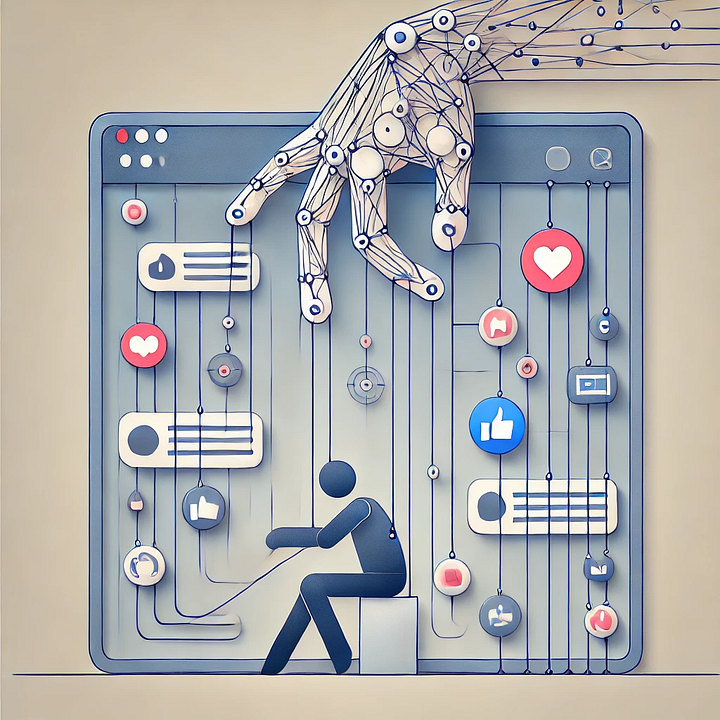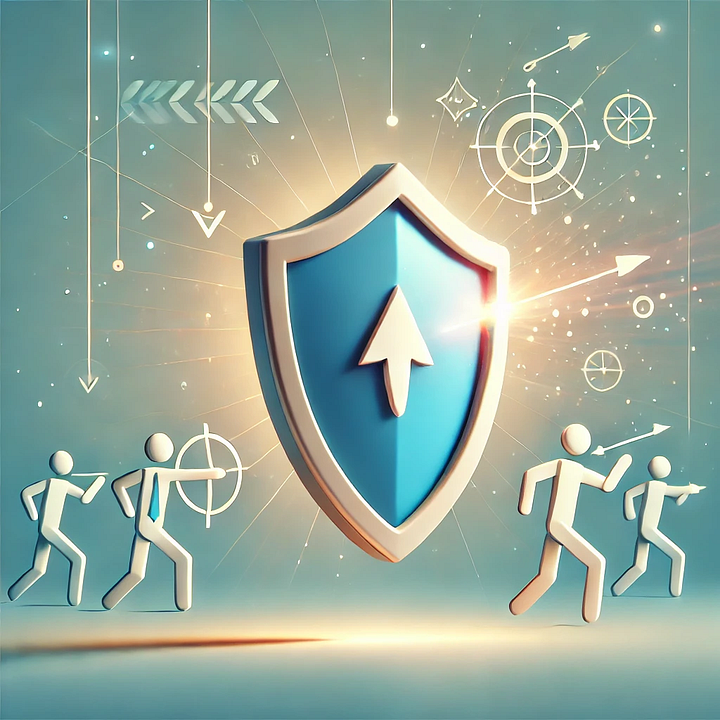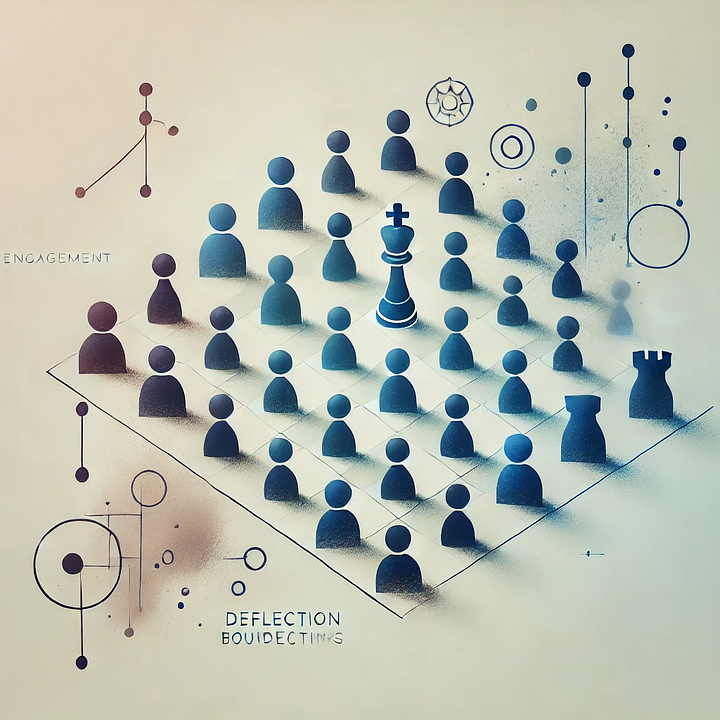How to Recognize, Resist, and Recover from Online Manipulation
In a world where words are weapons, learn to shield your heart without losing your humanity
Introduction
1.1 Overview of the case study
In the vast landscape of social media, where words are weapons and emotions run high, we find ourselves increasingly vulnerable to a particular breed of toxic behavior: online narcissistic abuse.
This case study delves deep into a recent Facebook exchange that serves as a chilling example of how narcissists operate in digital spaces.
Our subject, Jonathan Dotson, unwittingly provides us with a masterclass in manipulation, gaslighting, and emotional exploitation — tactics that can leave even the most self-aware individuals questioning their reality.
For those of you who have ever felt confused, hurt, or emotionally drained after an online interaction, this analysis is for you.
It’s especially crucial for the sensitive souls among us — the empaths, the idealists, the ones who see the best in others even when it costs us dearly.
If you’ve ever found yourself giving someone the benefit of the doubt long after red flags have appeared, or if you struggle to set boundaries for fear of hurting others, you’re not alone. This study will equip you with the knowledge and tools to protect your emotional wellbeing in the treacherous waters of online discourse.
1.2 Importance of understanding online narcissism
Understanding online narcissism is not just an academic exercise — it’s a vital skill for navigating the modern world. In an era where our lives are increasingly lived through screens, the ability to recognize and respond to narcissistic behavior can mean the difference between maintaining our mental health and falling into cycles of self-doubt and emotional turmoil.
For those of us who are naturally empathetic, who feel deeply and care intensely about others, online narcissists pose a particular threat. They prey on our desire for connection, our willingness to see the good in others, and our reluctance to engage in conflict. By understanding their tactics, we can learn to protect our sensitive hearts without losing our capacity for compassion.
This understanding is especially crucial for those who have experienced trauma or struggle with insecurity. Narcissists have an uncanny ability to sense vulnerability, and they often target those who are already questioning their worth or their perception of reality. By shining a light on their tactics, we reclaim our power and our ability to trust our own instincts.
1.3 Brief introduction to Game Theory in this context
As we dissect this online exchange, we’ll be viewing it through the lens of Game Theory — a framework typically used to analyze strategic decision-making. While it might seem unusual to apply such a structured approach to emotional interactions, Game Theory provides us with valuable insights into the underlying dynamics of narcissistic abuse.
In essence, Game Theory allows us to see these interactions as a series of moves and countermoves, each designed to achieve a specific outcome. For the narcissist, the goal is often to maintain control, avoid accountability, and extract emotional energy from their target. For the target, the objectives might include seeking validation, defending their perspective, or simply trying to engage in meaningful dialogue.
By framing these exchanges as a type of game, we can step back from the emotional intensity and see the patterns more clearly. This doesn’t mean that the pain isn’t real or that the stakes aren’t high. Rather, it gives us a tool to understand why narcissists behave the way they do, why their tactics are so effective, and most importantly, how we can change the game to protect ourselves.
For those of us who are more intuitive and feeling-oriented (like many INFPs), this analytical approach might feel foreign at first. However, combining our natural empathy and insight with this structured analysis can be incredibly powerful. It allows us to honor our emotional wisdom while also developing the tactical awareness needed to navigate these challenging interactions.
As we proceed through this case study, remember: knowledge is power. By understanding the game narcissists play, we can choose whether to engage, how to protect ourselves, and ultimately, how to create healthier spaces for genuine connection online. Your sensitivity is a strength, not a weakness — and armed with this knowledge, you can learn to use it as a shield rather than a target.

2. Background
2.1 Context of the Facebook thread
The digital stage for our case study is a Facebook thread — a seemingly innocuous space that quickly became a battleground of egos and manipulative tactics. Social media platforms like Facebook often serve as breeding grounds for narcissistic behavior due to their public nature and the instant gratification they provide through likes, comments, and shares.
For those of us who are more introverted or sensitive, these public forums can feel overwhelming. We might hesitate to engage, fearing conflict or misunderstanding. Yet, it’s often in these spaces that we encounter the most insidious forms of emotional manipulation. Understanding the context of this exchange is crucial, as it highlights how quickly a simple post can spiral into a complex web of narcissistic abuse.
2.2 Initial meme and comments
The catalyst for this interaction was a simple meme stating, “Be the same person privately, publicly, and personally.” This message, promoting authenticity and consistency, resonates deeply with those who value sincerity and genuine connection. For many empaths and idealists, this concept of authentic self-expression is not just a nice idea, but a core value.
The original poster (Mark) added a comment to this meme: “A narcissist can’t and simply won’t comply.” This statement cuts to the heart of narcissistic behavior — the inability or unwillingness to maintain a consistent, authentic self across different contexts. For those who have dealt with narcissistic individuals, this observation likely strikes a chord, validating experiences of encountering two-faced or manipulative behavior.
This combination of meme and comment set the stage for a discussion about authenticity, manipulation, and the challenges of interacting with narcissistic individuals. It’s a topic that can be particularly triggering for those who have experienced narcissistic abuse, as it touches on painful memories and ongoing struggles.
2.3 Introduction of Jonathan Dotson to the conversation
Enter Jonathan Dotson, whose comments would soon reveal a textbook display of narcissistic tactics. Jonathan’s initial response was to criticize the meme and the comment, accusing the poster of being “ableist” and “prejudiced.” This immediate jump to inflammatory language is a red flag, signaling an attempt to derail the conversation and shift focus away from the original point.
For those of us who are conflict-averse or prone to self-doubt, such accusations can be deeply unsettling. We might find ourselves questioning our intentions, wondering if we’ve inadvertently caused harm. This is precisely the reaction narcissists hope to provoke — confusion, self-doubt, and a defensive posture that puts us on the back foot from the start.
Jonathan’s entry into the conversation marks the beginning of a complex dance of manipulation, gaslighting, and emotional exploitation. His tactics, as we’ll explore in detail, are designed to control the narrative, avoid accountability, and extract emotional energy from others in the thread.
As we delve deeper into this exchange, it’s important to remember that narcissistic behavior often escalates gradually. What starts as a seemingly innocent disagreement can quickly morph into a barrage of manipulative tactics. For sensitive individuals, recognizing these early warning signs can be crucial in protecting our emotional wellbeing.
In the following sections, we’ll break down Jonathan’s tactics in detail, examining how each move is calculated to manipulate, confuse, and control. By understanding these strategies, we equip ourselves with the knowledge to recognize and resist narcissistic manipulation, both online and in our daily lives.

3. Analysis of Jonathan’s Narcissistic Tactics
3.1 Deflection and derailment
Jonathan’s initial response exemplifies two classic narcissistic tactics: deflection and derailment. By immediately labeling the meme and comment as “ableist” and “prejudiced,” he shifts the focus away from the original point about narcissistic behavior and onto a completely different topic.
For empathetic individuals, especially those with a strong sense of social justice, this tactic can be particularly effective. We may find ourselves suddenly on the defensive, trying to prove that we’re not prejudiced or insensitive. This emotional redirection is precisely what the narcissist wants — it puts them in control of the conversation and forces others to engage on their terms.
Recognizing deflection and derailment is crucial. When you notice a sudden, dramatic shift in the conversation’s focus, especially one that puts you on the defensive, it’s often a sign that you’re dealing with manipulative tactics.
3.2 Weaponizing labels
Jonathan’s use of charged terms like “ableist” and “prejudiced” is a prime example of weaponizing labels. This tactic is designed to shame and silence opposition by associating them with negative characteristics.
For sensitive individuals who deeply value fairness and kindness, being labeled with such terms can be deeply distressing. We may find ourselves spiraling into self-doubt, wondering if we’ve unknowingly caused harm. This emotional turmoil is exactly what the narcissist aims to provoke.
It’s important to remember that while these labels can be valid in appropriate contexts, narcissists often use them indiscriminately as a tool of manipulation. Learning to recognize when labels are being weaponized, rather than used constructively, is a key skill in protecting yourself from this tactic.
3.3 Cherry-picking and semantic smokescreening
As the conversation progresses, Jonathan employs cherry-picking and semantic smokescreening. He latches onto specific words or phrases, taking them out of context to construct a narrative that suits his purposes. This tactic is particularly evident when he focuses on the word “evil” in one of Mark’s responses, ignoring the broader context and intent of the argument.
For detail-oriented individuals, especially those who value precision in language, this tactic can be incredibly frustrating. We might find ourselves drawn into lengthy explanations and clarifications, trying to ensure our words aren’t misunderstood. However, this is often a fruitless endeavor with a narcissist, as their goal is not understanding, but control.
Recognizing when someone is consistently misrepresenting your words or fixating on semantics rather than engaging with your main points is crucial. It’s often a sign that you’re dealing with someone more interested in “winning” than in genuine dialogue.
3.4 Gaslighting and reality distortion
Throughout the exchange, Jonathan engages in gaslighting and reality distortion. He repeatedly denies or minimizes his own actions, while exaggerating or fabricating issues with others’ behavior. This is evident when he claims to have “missed” earlier parts of the conversation due to the “bluntness” of the meme, despite having actively engaged with those very points.
For individuals who already struggle with self-doubt or have a history of trauma, gaslighting can be particularly devastating. We may find ourselves questioning our own memories and perceptions, wondering if we’re the ones misremembering or misunderstanding the situation.
It’s crucial to trust your own experiences and perceptions. If you find yourself consistently doubting your memory or understanding of events when interacting with someone, it may be a sign that you’re being gaslighted.
3.5 Playing the victim
As the conversation escalates, Jonathan increasingly portrays himself as the victim. He accuses Mark of “bullying” and “harassment,” despite being the one who initiated the confrontational tone. This tactic is designed to garner sympathy and paint the narcissist as the wronged party.
For empathetic individuals, especially those with a strong desire to avoid causing harm, this tactic can be particularly effective. We may find ourselves backing down or apologizing, even when we’ve done nothing wrong, simply to alleviate the perceived suffering of the other person.
Remember, it’s possible to be compassionate without accepting false accusations or taking responsibility for someone else’s feelings. Learning to recognize when someone is consistently painting themselves as the victim, especially in situations they instigated, is key to protecting yourself from this manipulation tactic.
3.6 False apologies and manipulation
Throughout the exchange, Jonathan offers what appear to be apologies, but these are often followed by further attacks or justifications. For instance, he says, “Again I apologize for missing your point yesterday. I was wrong,” but immediately follows this with criticism: “Your choice of meme was still terrible.”
These false apologies are a manipulative tactic designed to appear reasonable and conciliatory while continuing the abusive behavior. For empathetic individuals who value sincere communication, these can be particularly confusing. We might find ourselves giving the benefit of the doubt repeatedly, hoping that this time the apology is genuine.
It’s important to recognize that true apologies come with changed behavior. If someone consistently “apologizes” but continues the same harmful actions, it’s likely that their apologies are merely another tool of manipulation.
3.7 Concern trolling
Jonathan employs concern trolling when he states, “I’m truly worried about your mental health.” This tactic involves expressing fake concern to undermine the other person’s credibility and emotional stability.
For those of us who struggle with self-doubt or mental health issues, this tactic can be particularly hurtful and destabilizing. We might start to question our own reactions and wonder if we’re overreacting or being “too sensitive.”
Remember, genuine concern for someone’s wellbeing doesn’t involve public shaming or using their perceived mental state as a weapon in an argument. If someone expresses “concern” in a way that makes you feel worse or doubts yourself, it’s likely not genuine concern at all.
3.8 Attempts to control the narrative
Throughout the entire exchange, Jonathan consistently attempts to control the narrative. He tries to dictate what topics are acceptable to discuss, how others should express themselves, and even how they should feel about the interaction.
For individuals who value harmony and are willing to compromise to keep the peace, this can be a challenging tactic to resist. We might find ourselves constantly adjusting our behavior or words to appease the narcissist, losing our own voice in the process.
It’s crucial to remember that in a healthy interaction, all parties have the right to express themselves and contribute to the direction of the conversation. If you find yourself constantly walking on eggshells or feeling like you can’t express your true thoughts without backlash, it may be a sign that someone is attempting to exert unhealthy control over the interaction.
By understanding these tactics, we can better equip ourselves to recognize and resist narcissistic manipulation in online spaces. For sensitive, empathetic individuals, this knowledge isn’t about becoming cynical or distrustful, but about learning to protect our emotional wellbeing while still remaining open to genuine connections.
In the next section, we’ll explore the responses and countermeasures employed to address these manipulative tactics.

4. Your Responses and Countermeasures
4.1 Maintaining focus on core issues
Throughout the exchange, Mark consistently attempts to bring the conversation back to the original topic: the harmful impact of narcissistic behavior. This is a crucial strategy when dealing with narcissistic manipulation, as it prevents the narcissist from completely derailing the conversation.
For those of us who are easily distracted or tend to get caught up in details, maintaining focus can be challenging. However, it’s an essential skill in protecting ourselves from manipulation. By repeatedly bringing the conversation back to the core issues, we deny the narcissist the opportunity to lead us down endless rabbit holes of deflection and distraction.
Practice: When you feel a conversation veering off-course, try to pause and ask yourself, “What was the original point we were discussing?” This can help you refocus and avoid getting lost in manipulative tangents.
4.2 Exposing manipulative tactics
A key strategy employed in this exchange is the explicit naming and exposing of Jonathan’s manipulative tactics. For example, Mark points out when Jonathan is using deflection, gaslighting, or playing the victim. This approach serves two purposes: it calls out the behavior in real-time, making it harder for the narcissist to deny, and it educates others who may be witnessing the exchange.
For empathetic individuals who often give others the benefit of the doubt, calling out manipulative behavior can feel uncomfortable or confrontational. However, it’s a powerful tool in combating narcissistic abuse. By naming the tactics, we reclaim our reality and make it harder for the narcissist to distort it.
Practice: Start by naming manipulative tactics in your own mind when you notice them. As you become more confident, you can begin to calmly and assertively point them out in your responses.
4.3 Setting and reinforcing boundaries
Throughout the exchange, Mark consistently sets and reinforces boundaries. He makes it clear that he won’t tolerate manipulative behavior, and he stands firm in his right to express his views and analyze the interaction.
For those of us who struggle with people-pleasing tendencies or fear of conflict, setting boundaries can be incredibly challenging. We might worry about hurting others’ feelings or causing discomfort. However, boundaries are crucial for our emotional wellbeing, especially when dealing with narcissistic individuals.
Practice: Start small by identifying one boundary you’d like to set in your online interactions. It could be as simple as deciding not to engage with comments that use personal attacks. Practice enforcing this boundary consistently.
4.4 Use of detailed analysis to counter gaslighting
One of the most powerful countermeasures employed in this exchange is the use of detailed analysis to combat gaslighting and reality distortion. By breaking down Jonathan’s comments and tactics point by point, Mark creates a clear record of the interaction that’s harder for Jonathan to deny or distort.
For individuals who struggle with self-doubt or have a history of being gaslighted, this technique can be particularly empowering. It provides a concrete reference point for what actually happened, making it easier to trust our own perceptions.
Practice: When you feel confused or doubtful about an interaction, try writing down exactly what was said or done. Be as objective and detailed as possible. This can help you see patterns of manipulation more clearly and trust your own experiences.
By employing these countermeasures, we can create a shield against narcissistic manipulation while still engaging in online spaces. Remember, the goal isn’t to “win” against narcissists, but to protect our emotional wellbeing and maintain our sense of reality in the face of manipulation.
In the next section, we’ll explore how Game Theory can provide additional insights into these types of interactions.

5. Game Theory Analysis
5.1 Introduction to relevant Game Theory concepts
Game Theory, at its core, is the study of strategic decision-making. In the context of our case study, it provides a framework for understanding the underlying dynamics of narcissistic online interactions. By viewing these exchanges as a series of strategic moves, we can gain insights into why narcissists behave the way they do and how we can better protect ourselves.
For those of us who are more emotionally-oriented, thinking of human interactions as a “game” might feel uncomfortable or overly analytical. However, this framework can provide a valuable emotional distance, allowing us to see patterns more clearly without getting caught up in the heat of the moment.
Key concepts we’ll be using include:
-
Players: The individuals involved in the interaction
-
Strategies: The choices available to each player
-
Payoffs: The outcomes or rewards for each combination of strategies
-
Nash Equilibrium: A state where no player can unilaterally improve their position
5.2 Modeling the interaction as a game
In our case study, we can model the interaction as a two-player game:
-
Player 1: Mark (the original poster)
-
Player 2: Jonathan (the narcissistic commenter)
Each “move” in the game represents a comment or response in the Facebook thread. The strategies available to each player include:
-
Engage directly with the topic
-
Deflect or derail
-
Call out manipulative behavior
-
Play the victim
-
Disengage
The payoffs in this game are more complex than simple wins or losses. They include:
-
Emotional energy (gained or depleted)
-
Control of the narrative
-
Public perception
-
Self-validation
5.3 Strategies employed by both parties
Jonathan’s primary strategy involves a combination of deflection, playing the victim, and attempting to control the narrative. His moves are designed to maximize his control over the conversation while depleting Mark’s emotional energy.
Mark’s strategy, on the other hand, focuses on maintaining focus on the core issues, exposing manipulative tactics, and setting firm boundaries. His moves aim to minimize the emotional drain while maintaining control over his own narrative.
5.4 Payoffs and outcomes
For Jonathan, the desired payoffs include:
-
Emotional supply from generating reactions
-
Control over the conversation
-
Avoidance of accountability
-
Reinforcement of his self-image as a victim or authority
For Mark, the desired payoffs include:
-
Maintaining emotional equilibrium
-
Exposing narcissistic tactics
-
Educating others about manipulation
-
Reinforcing personal boundaries
The actual outcomes of each move depend on how successfully each player executes their strategy and how well the other player counters it.
5.5 Nash equilibrium in narcissistic online interactions
In Game Theory, a Nash Equilibrium occurs when neither player can unilaterally improve their position by changing their strategy. In narcissistic online interactions, this often manifests as a stalemate where:
-
The narcissist continues to employ manipulative tactics
-
The target continues to call out these tactics and maintain boundaries
-
Neither party disengages, as the narcissist seeks continued emotional supply, and the target seeks to stand their ground
This equilibrium can be emotionally draining for both parties, but particularly for the target of narcissistic manipulation. Understanding this can help us make more informed decisions about when to engage and when to step away from these interactions.
By viewing narcissistic online interactions through the lens of Game Theory, we can better understand the strategic nature of these exchanges. This understanding empowers us to make more conscious choices about our own “moves” and to recognize when we’re being drawn into a game that doesn’t serve our well-being.
In the next section, we’ll explore the broader implications of these dynamics on online discourse and individual psychological well-being.

6. Broader Implications
6.1 Impact on online discourse
The prevalence of narcissistic behavior in online spaces has far-reaching consequences for the quality of digital discourse.
Firstly, it creates an atmosphere of hostility and defensiveness. When people frequently encounter manipulative tactics, they may become guarded in their interactions, less willing to share genuine thoughts and feelings. For sensitive individuals, this can lead to self-censorship or complete withdrawal from online discussions.
Secondly, narcissistic tactics can derail meaningful conversations. As we saw in our case study, Jonathan’s deflections and attempts to control the narrative repeatedly shifted the focus away from the original topic. On a larger scale, this pattern can prevent productive discussions on important issues, as conversations are constantly sidetracked by personal attacks and manipulative tactics.
Lastly, the presence of narcissistic behavior can create a sort of ‘empathy fatigue’ among online users. Constantly navigating these toxic interactions can wear down even the most compassionate individuals, potentially leading to a overall decrease in empathy and understanding in online spaces.
6.2 Psychological effects on targets of narcissistic manipulation
The psychological impact of being targeted by narcissistic manipulation online can be profound, especially for those who are already struggling with insecurity, past trauma, or mental health issues.
Repeated exposure to gaslighting can lead to a phenomenon known as ‘reality erosion’, where individuals begin to doubt their own perceptions and memories. This can exacerbate existing mental health issues and potentially lead to new ones, such as anxiety and depression.
The constant emotional drain of dealing with narcissistic tactics can also lead to a state of chronic stress. For highly sensitive individuals, this prolonged state of emotional arousal can be particularly damaging, potentially leading to burnout or even physical health issues.
Moreover, the experience of being manipulated online can spill over into offline life. Targets may become hypervigilant, constantly on guard for signs of manipulation in all their interactions. This can strain real-life relationships and make it difficult to trust others.
6.3 Challenges in moderating online spaces
The subtlety and complexity of narcissistic manipulation pose significant challenges for those tasked with moderating online spaces.
Firstly, many narcissistic tactics, such as gaslighting or playing the victim, can be difficult to identify without context. A single comment may not violate community guidelines, even if it’s part of a larger pattern of manipulative behavior.
Secondly, narcissists are often adept at presenting themselves as the wronged party. They may weaponize moderation systems, reporting their targets for “harassment” when they’re called out on their behavior. This can lead to a paradoxical situation where those standing up to manipulation are penalized.
Lastly, the sheer volume of online interactions makes it impossible for human moderators to closely monitor every exchange. While AI moderation tools are improving, they still struggle with the nuanced nature of narcissistic manipulation.
These challenges highlight the need for more sophisticated approaches to online moderation, as well as better education for users on recognizing and responding to manipulative tactics.
Understanding these broader implications is crucial for anyone navigating online spaces, especially those who are more sensitive or empathetic. It underscores the importance of developing resilience, setting firm boundaries, and sometimes, knowing when to disengage for the sake of one’s own well-being.
In our next section, we’ll discuss specific strategies for dealing with online narcissists, drawing from the insights gained in our case study and broader analysis.

7. Strategies for Dealing with Online Narcissists
7.1 Recognizing narcissistic tactics
The first step in protecting yourself from online narcissists is learning to recognize their tactics. Based on our case study, here are some key signs to watch for:
-
Deflection and derailment: Watch for sudden topic changes or attempts to shift blame.
-
Gaslighting: Be alert to statements that make you doubt your perception of events.
-
Playing the victim: Notice if someone consistently portrays themselves as the wronged party, especially in situations they instigated.
-
False apologies: Look out for “apologies” followed immediately by further attacks or justifications.
-
Concern trolling: Be wary of expressions of “concern” that feel undermining or manipulative.
For empathetic individuals, it’s crucial to trust your instincts. If an interaction leaves you feeling confused, drained, or questioning your own sanity, it may be a sign that you’re dealing with narcissistic manipulation.
7.2 Maintaining emotional distance
One of the most effective strategies for dealing with online narcissists is maintaining emotional distance. This can be challenging, especially for those of us who are naturally empathetic or sensitive. Here are some techniques:
-
Imagine you’re observing the interaction as a third party. This can help you see manipulative tactics more clearly.
-
Remember that the narcissist’s behavior is about them, not you. Their attacks and manipulations are often projections of their own insecurities.
-
Practice mindfulness. Stay aware of your emotional state during online interactions, and step away if you feel yourself becoming too emotionally invested.
7.3 Setting firm boundaries
Setting and maintaining boundaries is crucial when dealing with narcissists online. This might include:
-
Deciding what kinds of comments you will and won’t engage with.
-
Limiting the time you spend in potentially toxic online spaces.
-
Being clear about what behavior you won’t tolerate in your online interactions.
Remember, you have the right to set boundaries in your online interactions. It’s not unkind or selfish to protect your emotional well-being.
7.4 Documenting interactions
As we saw in our case study, documenting interactions can be a powerful tool against gaslighting and reality distortion. Consider:
-
Taking screenshots of problematic interactions.
-
Keeping a journal of your experiences and feelings after difficult online exchanges.
-
If you’re dealing with persistent harassment, consider compiling evidence for platform moderators.
This documentation serves dual purposes: it helps you maintain your grip on reality, and it provides evidence if you need to report abusive behavior.
7.5 Seeking support and allies
Dealing with narcissistic manipulation can be isolating, but remember that you’re not alone. Consider:
-
Sharing your experiences with trusted friends or family members.
-
Joining online support groups for people dealing with narcissistic abuse.
-
If online interactions are significantly impacting your mental health, consider speaking with a therapist who understands narcissistic abuse.
For introverted or sensitive individuals, reaching out can feel challenging, but having a support system is crucial in maintaining your emotional well-being.
Remember, engaging with online narcissists is not a battle you’re obligated to fight. Sometimes, the healthiest strategy is to disengage and focus your energy on more positive interactions. Your emotional well-being should always be your priority.
In our final section, we’ll conclude by recapping the key points of our analysis and discussing the broader implications for creating healthier online spaces.

8. Conclusion
8.1 Recap of key narcissistic tactics observed
Throughout our case study, we’ve observed a range of narcissistic tactics employed in online interactions:
-
Deflection and derailment
-
Weaponizing labels
-
Cherry-picking and semantic smokescreening
-
Gaslighting and reality distortion
-
Playing the victim
-
False apologies and manipulation
-
Concern trolling
-
Attempts to control the narrative
These tactics, while diverse, all serve the narcissist’s core goals: maintaining control, avoiding accountability, and extracting emotional energy from their targets.
8.2 Importance of awareness and resilience
Understanding these tactics is crucial for navigating online spaces safely and maintaining our emotional well-being. For sensitive, empathetic individuals, this awareness is particularly important. It allows us to engage authentically online while protecting ourselves from manipulation and abuse.
Resilience, in this context, doesn’t mean becoming hardened or cynical. Instead, it’s about developing the tools to recognize manipulative behavior, maintain our sense of reality, and make conscious choices about how and when to engage.
8.3 Call to action for creating healthier online spaces
As we’ve seen, narcissistic behavior online doesn’t just affect individuals — it impacts the quality of our collective discourse and the health of our digital communities. Therefore, addressing this issue requires both individual and collective action:
For individuals:
-
Commit to ongoing education about narcissistic tactics and healthy online interaction.
-
Practice setting and maintaining boundaries in your online engagements.
-
Support others who are standing up to manipulation and abuse.
For platform developers and moderators:
-
Develop more nuanced policies and tools for identifying and addressing patterns of manipulative behavior.
-
Provide better resources and support for users dealing with online abuse.
For mental health professionals:
-
Recognize the impact of online narcissistic abuse and incorporate this understanding into treatment approaches.
-
Develop resources specifically tailored to helping individuals navigate toxic online interactions.
For researchers:
-
Continue to study the dynamics of online narcissism and its impacts on individual and community well-being.
-
Develop and test interventions for creating healthier online environments.
By working together on these fronts, we can create online spaces that foster genuine connection, meaningful dialogue, and mutual respect — spaces where empathy and sensitivity are strengths, not vulnerabilities to be exploited.
Remember, your voice matters. Your experiences are valid. And you have the right to engage online without sacrificing your emotional well-being. By understanding narcissistic tactics and employing strategies to protect ourselves, we can all contribute to creating a healthier, more empathetic digital world.
As we conclude this analysis, let it serve not just as a warning about the dangers lurking in online spaces, but as a beacon of hope. Armed with knowledge and supported by a community that values genuine connection, we can navigate even the stormiest online waters with grace, strength, and authenticity.

9. References and Further Reading
Books:
-
The Narcissism Epidemic: Living in the Age of Entitlement by Jean M. Twenge and W. Keith Campbell
-
Rethinking Narcissism by Dr. Craig Malkin
-
Disarming the Narcissist: Surviving and Thriving with the Self-Absorbed by Wendy T. Behary
-
The Empathy Trap: Understanding Antisocial Personalities by Dr. Jane McGregor and Tim McGregor
Academic papers:
-
“Narcissism and Social Networking Behavior: A Meta-Analysis” by Tara C. Marshall et al.
-
“The Dark Side of Facebook: The Dark Tetrad, Negative Social Potency, and Trolling Behaviours” by Evita March et al.
-
“Trolls just want to have fun: Mediating the relationship between sadism and trolling behaviour on social media” by Erin E. Buckels et al.
Online resources:
-
The National Domestic Violence Hotline’s resources on digital abuse
-
Out of the FOG (Fear, Obligation, and Guilt) — website dedicated to supporting those affected by personality disorders

10. Future Work
10.1 Case Study Follow-up
We plan to revisit the original Facebook thread in 3–6 months to analyze any long-term impacts of the interaction. Specifically, we’ll examine:
-
Any continued engagement from Jonathan or other participants
-
Changes in the overall tone of discussions on the page
-
Implementation of any new moderation policies or community guidelines
-
Feedback from other users about how the interaction affected their perception of online discourse
This longitudinal approach will provide valuable insights into the lasting effects of narcissistic behavior on online communities and the efficacy of various countermeasures over time.
10.2 Expert Opinions
We aim to conduct interviews with:
-
Dr. Ramani Durvasula, clinical psychologist and narcissism expert
-
Danielle Citron, law professor specializing in online harassment
-
A senior content moderator from a major social media platform (anonymity maintained)
These experts will provide professional perspectives on:
-
The psychological motivations behind online narcissistic behavior
-
Legal and ethical considerations in addressing online manipulation
-
Practical challenges and potential solutions in moderating narcissistic behavior at scale
Their insights will be synthesized into a comprehensive framework for understanding and addressing online narcissism across individual, community, and platform levels.
10.3 Reader Engagement Section
We will create an interactive web portal where readers can:
-
Submit their own experiences with online narcissism through a structured questionnaire
-
Participate in moderated forums discussing coping strategies
-
Access resources such as articles, videos, and support group information
Additionally, we’ll pose specific scenarios and ask readers to share how they would respond, creating a crowdsourced handbook of practical strategies for dealing with online manipulation.
Data collected will be anonymized and analyzed to identify patterns in narcissistic behavior and effective countermeasures, informing future research and articles.
10.4 Infographic or Visual Summary
We will develop a series of infographics:
-
“The Anatomy of an Online Narcissist”: Visual breakdown of common tactics
-
“Your Digital Shield”: Illustrated guide to protective strategies
-
“Red Flags in Online Interactions”: Quick reference for identifying manipulative behavior
-
“The Empathy Warrior’s Toolkit”: Visual representation of emotional first-aid techniques
These infographics will be designed for easy sharing on various social media platforms, optimized for both mobile and desktop viewing. We’ll track their spread and engagement to measure their impact on raising awareness about online narcissism.
10.5 Other Projects
In the future, we hope to develop:
-
Peer-reviewed journal papers focused exclusively on online narcissism and related topics
-
A series of online courses, ranging from beginner to advanced levels, on recognizing and countering narcissistic manipulation
-
A curated podcast series featuring interviews with authors, researchers, and survivors of online narcissistic abuse
By implementing these expanded future work initiatives, we aim to create a dynamic, evolving resource that not only educates and empowers individuals but also contributes significantly to the broader understanding and mitigation of online narcissism.
See the original article published on our new Neutralizing Narcissism Substack page for more information, addendums, and updates.
Copyright © 2024 Neutralizing Narcissism and Mark Randall Havens